Trying to gain organizational alignment on the best path forward on a critical product or organizational decision is overly difficult. Product-centric, inside-out organizations use “wear them down” decision-making techniques that leads to the “Least Worst” option because that option offends the fewest stakeholders.
This “lowest common denominator” approach leads to sub-optimal decisions from the perspective of what’s important to the customers. That’s like having LeBron James on your basketball team but forcing everyone on the team to play at the level of Jared Dudley (sorry man). The “Least Common Denominator” decision-making makes no one happy and benefits the target customers not.
To break this model, organizations need to embrace a customer-centric, outside-in perspective where internal stakeholders can identify, understand and empathize with their target customers. Organizations can avoid the “Least Worst” dilemma by gaining a deep understanding of their target customers, their jobs-to-be-done and the associated gains and pains against which to make the best “Best Option” trade-off decisions.
I want to use this blog to “think out loud” regarding how Design Thinking can help organizations move towards the best “Best Option.
The Role of Design Thinking
Design Thinking – and its guidance in identifying and understanding the sources of customer gains and pains to accomplish a particular challenge – is the best way to avert this “Least Worst” dilemma. Design Thinking discovers unmet market, product and service needs via direct customer engagement within the context and constraints of a specific customer opportunity. Design Thinking frames the opportunity, generates creative ideas, prototypes, tests and refines solutions. Let’s look at how we can leverage the customer journey map to avoid this “Least Worst” dilemma.
Design Thinking: Vehicle for Driving Towards the Best “Best Option”
A Customer Journey Map is a simple exercise for gaining a deep understanding of your targeted user. Think of the Customer Journey Map as a type of storyboard to identify the customer’s jobs to be done, and the associated gains (value statements) and pains (impediments) to accomplish a particular challenge (e.g., buying insurance, selecting a vacation, building a compressor, repairing an inoperable train).
Let’s see how we can leverage Design Thinking to come up with the best “Best Option.”
Let’s say that the Challenge Statement for our targeted market segment is focused on “Reducing Unplanned Operational Downtime”. This market segment could include hospitals, oil refineries, factories, production plants, stadiums, theme parks, malls, universities, power plants and any operation where unplanned operational downtime is can be a financial disaster while simultaneously dragging down customer satisfaction.
Let’s start by creating a Customer Profile for each of our targeted Personas (see Figure 1).
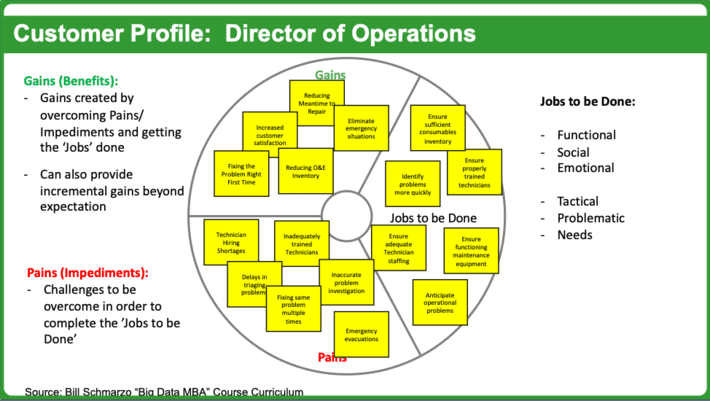
Figure 1: Customer Profile: Director of Operations
The Customer Profile captures the following information:
- The jobs-to-be-done (actions or decisions) that Persona needs to accomplish in support of the organization’s challenge statement— what the organization is trying to accomplish, the value propositions, the metrics against which progress and success will be measured.
- Gains (or Benefits) that the targeted Persona will realize. These are the Gains created by the ’Jobs to be Done’.
- Pains (or Impediments), which are the challenges the targeted Persona needs to overcome in order to complete the ’Jobs to be Done.’
Next, I want to expand the Customer Profile Canvas by creating a Customer Journey Map for each Persona (Operations, Procurement, Marketing, Maintenance, Inventory Management, etc.). For this exercise, I created an aggregated Customer Journey Map (see Figure 2).
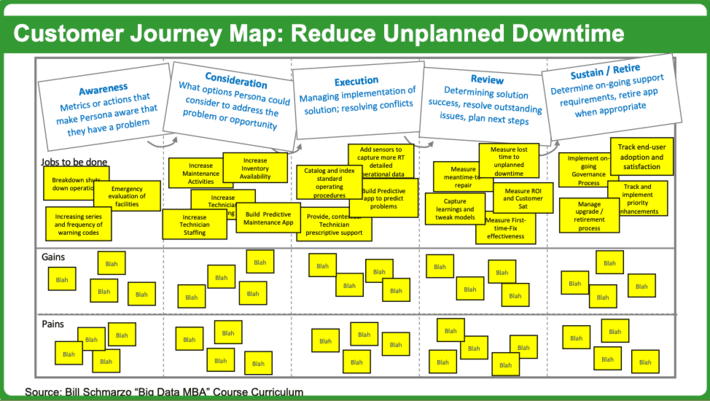
Figure 2: Head of Operations Customer Journey Map
The advantage of the Customer Journey Map is that it provides yet another, more detailed perspective on the “jobs to be done” and the pains and gains associated with each of the 5 stages of the journey (Note: your journey can have more or less than 5 stages. Think of this template as a guideline, not a decree.)
Finally, I want to move into Solution mode using the Customer Value Map which identifies:
- The different product and service components or assets that can be assembled in helping our targeted Personas achieve their jobs-to-be-done.
- Gain Creators, which details how we can provide the targeted Persona with expected gains and incremental benefits based on our Products and Services.
- Pain Relievers, which outlines we can provide Pain relief for the targeted Persona’s challenges based on our Products and Services.
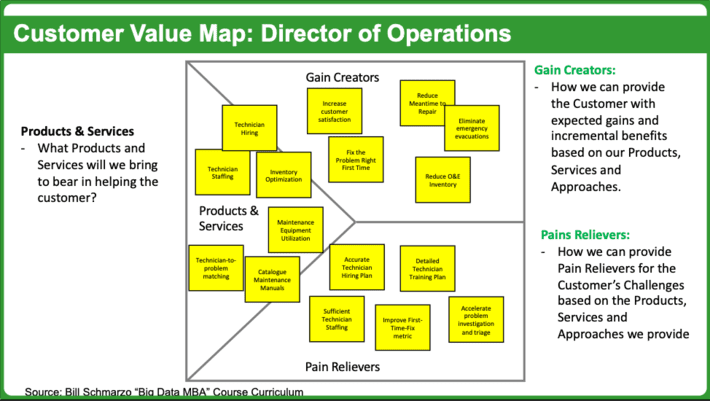
Figure 3: Customer Value Map
Once we have done this exercise for each targeted Persona, we now have a comprehensive list of the Jobs-to-be-done and the associated Gains and Pains. We can then leverage an envisioning workshop that brings together the key stakeholders to debate, evaluate and blend the jobs-to-be-done into potential solution options (see Figure 4).
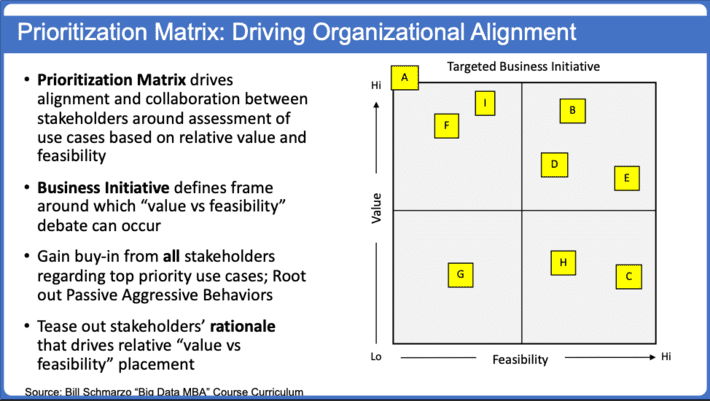
Figure 4: Prioritization Matrix
One trick to facilitating this prioritization process is to focus on understanding the rationale behind gains and pains with respect to their relative positioning of the different options. It is from the understanding of the rationale that we can work towards the best “Best Option”; to blend the best rationale from the different options that leads to the best “Best Option”.
Once you have documented and categorized the rationale from the different stakeholders, the stakeholders now have an unbiased, value-based way to blend different rationales in new ways to create new value for your targeted customer while avoiding personality attacks.
Summary: Avoiding the “Least Worst” Dilemma
Here’s what organizations can do to avoid the “Least Worst” dilemma, and instead focus the organization on working towards the best “Best Option”:
- Seek to clearly understand the targeted customer challenge through the use of Persona Profiles and Customer Journey Maps.
- Identify and gain consensus on the target customer’s jobs-to-be-done, gains and pains to understand the sources of value associated with the target customer challenge.
- Evaluate, ideate and blend the jobs-to-be-done, gains and pains to propose potential solutions to solve the customer challenge.
- Debate the rationale (not the personalities) behind the different solutions based upon the gains and pains associated with each option.
- Finally, look for opportunities to integrate or blend the different rationale in new ways in order to create the best “Best Option”.
All this customer-centric thinking and ideation comes together in create a customer-centricity driven digital transformation value creation roadmap that can continuously learn about customers in order to provide on-going value including in Figure 5:
- Identification of Sources of Value Creation through an Intimate understanding of what the customer is trying to accomplish and why it’s important to their business and operational models within the context of driving organizational alignment and adoption.
- Codifying the Sources of Value Creation via composable, reusable data and analytic “assets” that can be cobbled together based upon the customer’s business and operational needs.
- Operationalization the Sources of Value Creation by integrating the resulting data and analytic insights into the organization’s value chain / value network / value ecosystem in a dynamic, agile format that drives scale.
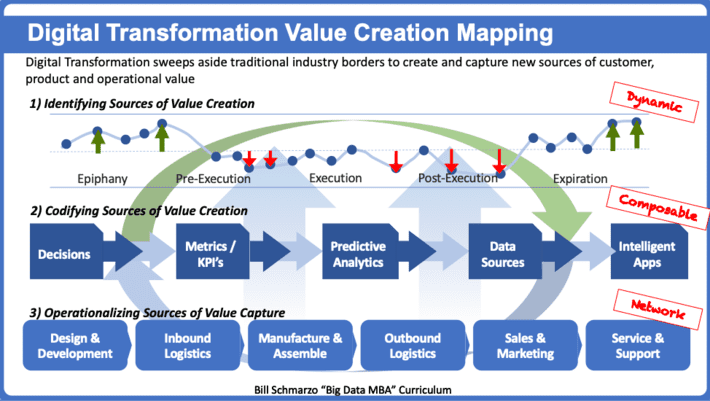
I hope this Design Thinking process can help your organization to not only avoid the “Least Worst” option, but can help to drive cross-organizational collaboration and, ultimately, alignment to pursue the best “Best Option.” Now, if we could only get our political leaders to think like this…
